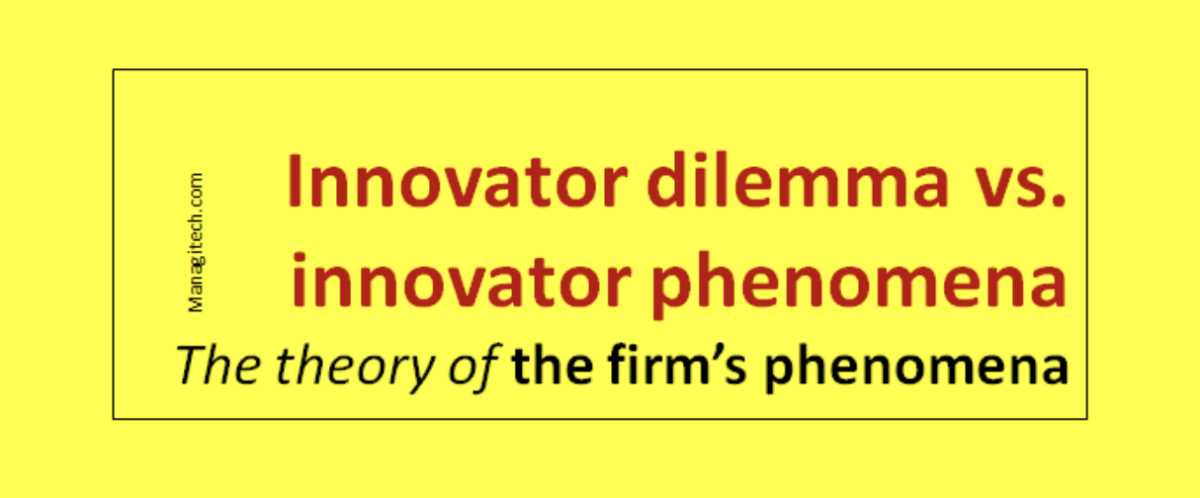Established firms’ strategies remain characterized by the inability to master—some will say even comprehend—the economics of choosing. It is particularly surfacing unresolved relationships between [1] technical-technological, [2] economic and [3] social combinations taking place within established firms e.g. manufactured product.
Hayek (1937) already explained that “Since equilibrium is a relationship between actions, and since the actions of one person [here the board of directors] must necessarily take place successively in time, the passage of time is impossible to exclude from a meaningful equilibrium theory.” Lakatos (1970) brought a contextualization by saying that since we replace a theory in the light of an alternative, we should consider not isolated theories but a sequence of them in a “scientific research program.” Decisively, Senge (1990) declared that system thinking is a philosophical alternative to pervasive “reductionisms” in Western culture including the pursuit of simple answer to complex issues. Recently, Noteboom (2010) circumscribe a description as “hard core explanatory principles, surrounded by a protected belt of subsidiary assumptions.”
Reconciled Candidate Innovation Methods
1. On the technical-technological front, Clayton Christensen (1997) demonstrated that “successful, outstanding companies can do everything ‘right’ and yet still lose their market leadership—or even fail—as new, unexpected competitors rise and take over the market.” In this vein, Clayton explained that the technical trajectory of the firm was becoming obsolete because a new one was interfering, overnight, coming from “the low end of the market,” in the form of new economic patterns, leaving the owners of the market at bay.
2. On the organizational front, with entry thinking initiated by Penrose (1959), David Teece, (1997, 2017) argues that production function is quite sterile and demonstrated that intellectual impasse could be opted out while applying the capabilities principles. In short, tangible and intangible resources, and more, upscale themselves into capabilities. As such, ordinary capabilities allow “to do things right” (efficiency) and dynamic capabilities “to do the right thing” (innovation).
3. Both theories enjoy an overwhelming consensus and admiration, although with an enduring quality of being “abstract” and “with limited utility.” In fact, practitioners agree both, but do not mark out quantitatively any. To my assumption, both principles are belonging to the same mechanism and therefore are both part of the solution. Accordingly, it must be reconciled.
Disruptive Innovation Capability = Technical Path Dependency
4. Regarding the disruption theory, we are now accustomed that “lucky entrepreneur” can take over the market from the established firm. Technically speaking, it means that we can find a continuum, but economically there is a shift in ownership. The process turns in “new hands of competencies,” organized “against” the established firm (Christensen, 1998). As a matter of fact, innovation scorecards of established firms eventually reveal a “hard core.” Academics call it path dependency, which is singled out in the disruption phase. Schumpeter (1934) already told us “that the economic perfect and the technological perfect need not, yet very often do diverge, not only because of ignorance and indolence but because methods which are technologically inferior […]. At this point the economic element is sharply contrasted with the technological.” Critically, practitioners need a new repertoire of action that isolates the path dependency i.e. disruptive capability.
5. Regarding the capabilities theory, researchers like Ambrosini and Bowman (2008) support that “while many fields address change-related issues (eg. organization learning, cognition, innovation …) none, expect the dynamic capability perspective, specifically focuses on how firm can change their valuable resources over time and do so persistently.” Yet, Winter and Nelson (2002) alerted us that, amid “an impressionistic level of competence puzzle,” a repetitive enforcement of capabilities seems to hold a secret, an opaque meaning that is trapped in the bizarre. “Real actors simply do not have the vast computational and cognitive powers that are imputed to them by optimization-based theories. Decisions defy basic principles of rationality and sometimes border on the bizarre.” Disruptive capability “at the heart of innovation” aims to unlock the philosophical bizarre.
6. Unfortunately so far, economic reality does not necessarily carry out the methods to their logical conclusion and with technological completeness, but subordinates the execution to economic points of view (Schumpeter, 1934). A possible transcript could be that zero level, ordinary and dynamic capabilities are economic in nature and disruptive capability is technical. To prevent falling into the hands of lucky entrepreneur, practitioners need to overcome this bizarre sequence by isolating a firm’s disruptive capability that will be instrumental to sense, seize and reconfigure.
Systemic Economic Phenomenon Unfold During Consecutive Materialisation of Four Types of Capabilities
7. Upon Nelson and Winter, solution paths may include a steady state or a set of them. But the commitment to the […] behavioral assumptions does not depend on the achievement of steady state. [On the contrary], modelers typically sought to analyze behavior and phenomena under roughly out of the equilibrium. Edmund Hesser (1859-1938) is speaking about “pure consciousness” which can be reached through “phenomenal reduction;” a method whereby all factual knowledge and reasoned assumptions about a phenomenon are set aside so that pure intuition of its essence may be analysed.
8. This is where disruptive innovation and its dilemma settle into its firm phenomena. All four does magnify an organic and systemic economic phenomenon that is composed of zero level capability [Nelson and Winter, 2002], ordinary and dynamic capability [Teece, 1997-2020] and disruptive capability [Chenevier, 2021]. Dilemma becomes phenomena paradigm; the later bearing one passage of time ref. ad infinitum (Collis, 1994).
9. This mental model, definitively optimistic, intends to comprehend the end of an economic phenomenon (yours as a board member?) as blackboard time to reconfigure the technical orchestration, on the premises of “the last thing.”
Source: https://innovationmanagement.se/2021/12/07/innovator-dilemma-vs-innovator-phenomena-the-theory-of-the-firms-phenomena/

